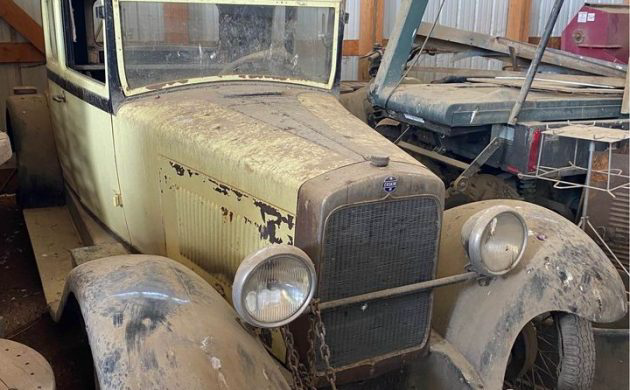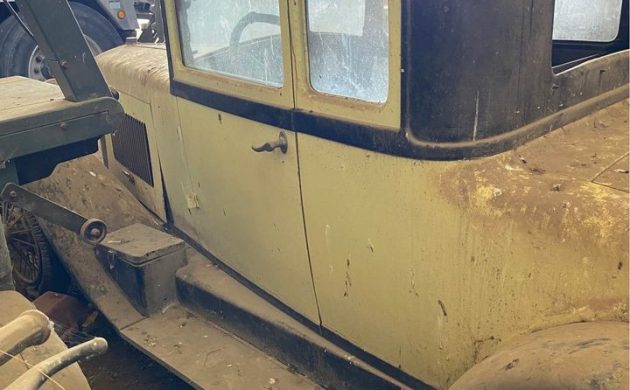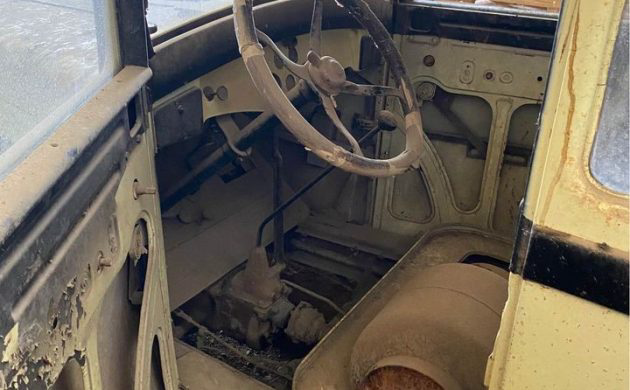The history of the American automobile is one of expansion and consolidation with a lot of drama thrown in for good measure. As Americans fell in love with the automobile, dozens of companies sprang up to meet the wants and needs of a population enamored with this new form of travel. Many of these companies came and went, while others grew into giants only to eventually disappear. Studebaker was a legendary manufacturer of horse-drawn wagons before the car arrived on the scene and was able to pivot into the automobile business in a big way. Wanting to copy the tiered-branding success of General Motors, Studebaker launched two separate lower-cost nameplates in the late 1920s and early 1930s. This 1927 Erskine coupe is a solid yet needy example of this unusual and seldom-seen foray into the low-cost field.
The Erskine is named after then-Studebaker president Albert Erskine. Erskine piloted Studebaker through the turbulent 1920s and was able to move the brand up the market by improving both the quality of the vehicles produced and steadily increasing the horsepower and overall performance of their engines. Of course, these changes also left Studebaker without a competitor in the lucrative but highly competitive lower end of the market. Erskine felt that a smaller automobile that was similar to the cars that were popular in Europe at the time would be a big seller in the United States.
When this smaller car debuted in 1927, it was probably obvious from the start that it would not be a sales success. The starting price was $995 in a world where a comparable Chevrolet was about $700. You could still get a Model T Ford for under $500 as well. The Erskine, named after the previously mentioned company president, was a well-built car with a Continental-built inline-six-cylinder engine. The real problem came in 1928 when Ford’s Model A debuted. Ford’s incredible popularity combined with Chevrolet’s strong showing in the segment left little for any other manufacturer at the low end of the market. The Erskine lasted only until 1930. Its successor, the Rockne (named after the famous football coach) debuted in 1931 and lasted until 1933. Albert Erskine sadly committed suicide at the Studebaker Proving Grounds in 1933 after realizing that he would soon lose control of the company.
Seeing an Erskine today is rare. Roughly 100,000 of these cars were made over their short production run, so specific parts soon dried up. Also, the chances of rebirth through restoration for these cars were dim. Orphan cars don’t enjoy the popularity and aftermarket support of more common vehicles as a rule. Today’s technology could work to make purchasing a surviving car like this 1927 Erskine coupe easier given the advances we have seen in 3D printing and CNC machining of reproduction parts. This example is said to need carburetor work and the engine is currently stuck despite turning freely just two years ago. The car was moved at that time, and by the looks of the rear tire, it appears that delicate care was somewhat absent.
In addition to the good condition of the body from what we can see in the pictures, several additional body parts also come with the vehicle. It appears that it is missing the seats both in the cabin and in the rumble. This should not be too much of an issue, as there are companies that will reproduce seat springs if given the original dimensions. Continental engine parts are also available given the fact that the company provided engines for a number of the smaller automobile and truck manufacturers.
If you are in the market for a seldom-seen orphan automobile, then this 1927 Erskine coupe for sale on Facebook Marketplace in Lakefield, Minnesota may be the project you are looking for. This lower-end product of the Studebaker Corporation is solid and ready to be put back on the road with a little work and a fair amount of folding money. The seller tells us that the car has always been kept inside and that they are open to offers. The car has a $6,500 asking price and a few extra parts to help you complete this unusual project. Hopefully, someone will take on this project so that new generations can learn a little history about the automobile industry when it was a lot more diverse than it is today. Thanks to NW Iowa Kevin for the tip!







Good write up as usual, Jeff.
Never heard of one before.
A good idea with good engineering approach, which might make it more appealing to someone looking for something a little different from the era to save.
Third time was the charm, in 1939 they made yet another foray into the low-priced field with the Studebaker Champion and it was quite successful.
Great write up Jeff. And thank you for all the time and research. I always learn something new on Barnfinds. I have heard of the Rockne but not the Erskine. I’d love to see this one restored, just because of its rarity, although I agree that parts that were specific to these may be hard to come by.
This is one that makes me wish my garage that I’m saving for was built already. I would love to work on getting the engine unstuck using some old school methods I learned years ago if the body is not all rotten I would focus on getting it running and driving that might mean changing over the brake system to something more available but looks to be a fun project
Again folks, why advertise in such a lucrative place as FB????? more people each day are dropping out of this mind control social media site.Put it out somewhere where normal people can see=buy it. I’m interested but know of no one left around here that is on META…sad.
Just curious Al, where do “normal “ people look, when they are shopping for classic car?
My ’29 Pontiac had Erskine Hubcaps on its Artillery wheels when I bought on June 4. 1960. They were cross hacksawed on the threads to allow them to fit the Pontiac’s ever so slightly larger hubs. I put them in a picture frame along with the obviously aftermarket horn which I left rusted as a memento of the day my life changed forever.
Jeff, can you please fix the Erskine spelling in several places where its anagram was inserted by accident? Very rare car here. Wiki shows a surprising 24,000+ units sold in 1927 of all body styles. I wonder how many of those were coupes and how many remain.
Nice write up Jeff !
I am sorry for the spelling snafus. Not sure if it was me, auto correct, or AI.
Thank you for all of the positive comments despite my errors. Hopefully someone saves this car no matter how the name is spelled! I sure hate to see these old orphan cars fading away.